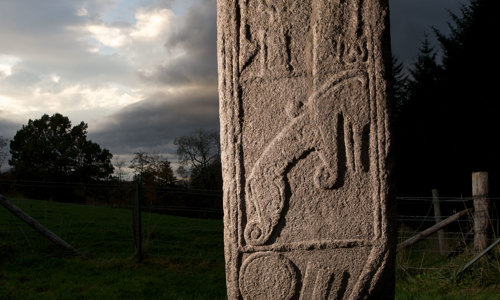History
Mysterious inscription
Along the length of the cross-slab’s right-hand side we can see an inscription in ogham. This is one of about 30 examples of this linear lettering found on Pictish stones. It consists of groups of horizontal or diagonal strokes along or across a vertical line.
The inscription on the Dyce cross-slab reads:
EOTTASSARRHETODDEDDOTSMAQQROGODDADD
What it means is a mystery. The last portion could be a person’s name, Rogoddadd. The rest can’t be interpreted, but the first portion might also be a personal name, giving the inscription, ‘??? ??? son of Rogoddadd’.
Ogham seems to have been introduced to the Picts by AD 600. Unlike Latin script, it could be easily carved into wood or stone – but it was only suitable for brief messages.
Something in the symbols
The ogham is not the only noteworthy carving on the Dyce Symbol Stones. The older of the two stones, a pink-red granite symbol stone, carries a swimming beast above a double disc and Z-rod. Each disc features an inner circle and central dot.
The cross-slab features a boldly-sculpted cross, entirely filled with interlace. Clustered around the cross are four symbols:
-
a crescent and a V-rod above a triple disc on the left
-
a mirror case on the right
-
a double disc and Z-rod below the mirror case
Evidence points to Dyce as the site of an early and important Pictish church. The presence of the earlier symbol stone may suggest it was originally a pagan site that was converted to Christian use.
Legacy of the Picts
We don’t know a lot about the Picts, the descendants of Iron-Age tribes who occupied the area north of the Forth and Clyde estuaries in the first millennium AD. They left about 300 carved stones, mainly in the north-east of the country. The earliest of these stones date to about AD 600 and display a characteristic repertoire of symbols.
The later group of Pictish stones, after about AD 700, were more overtly Christian. On these, the Christian cross dominates the traditional symbols.
We don’t know why the Picts erected these stones. They might be:
-
memorials to warriors
-
boundary markers between neighbouring tribes
-
representing marriage alliances
Whatever their purpose, they are skilfully executed works of art.












